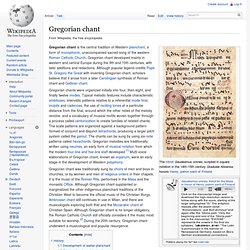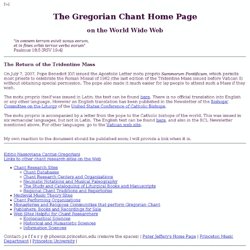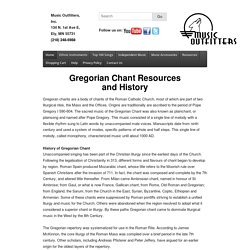

Gregorian chant. Gregorian chant is the central tradition of Western plainchant, a form of monophonic, unaccompanied sacred song of the western Roman Catholic Church.

Gregorian chant developed mainly in western and central Europe during the 9th and 10th centuries, with later additions and redactions. Although popular legend credits Pope St. Gregory the Great with inventing Gregorian chant, scholars believe that it arose from a later Carolingian synthesis of Roman chant and Gallican chant. History[edit] Development of earlier plainchant[edit] Musical elements that would later be used in the Roman Rite began to appear in the 3rd century. Scholars are still debating how plainchant developed during the 5th through the 9th centuries, as information from this period is scarce. John the Deacon, biographer (c. 872) of Pope Gregory I, modestly claimed that the saint "compiled a patchwork antiphonary",[11] unsurprisingly, given his considerable work with liturgical development. Origins of mature plainchant[edit] Gregorian Chant Home Page. On the World Wide Web "in omnem terram exivit sonus eorum, et in fines orbis terrae verba eorum" Psalmus 18:5 [RSV 19:4] The Return of the Tridentine Mass On July 7, 2007, Pope Benedict XVI issued the Apostolic Letter motu proprio Summorum Pontificum , which permits most priests to celebrate the Roman Missal of 1962 (the last edition of the Tridentine Mass issued before Vatican II) without obtaining special permission.

The pope also made it much easier for lay people to attend such a Mass if they wish. The motu proprio itself was issued in Latin; the text can be found here . The motu proprio is accompanied by a letter from the pope to the Catholic bishops of the world. My own reaction to the document should be published soon; I will provide a link when it is. Editio Nassoviana Cantus Gregoriani Links to other chant research sites on the Web Contact: j e f f e r y @ phoenix.princeton.edu (remove the spaces) | Peter Jeffery's Home Page | Princeton Music Department | Princeton University | Italy. Gregorian Chant: A Guide. Gregorian Chant Resources and History.
Gregoran chants are a body of chants of the Roman Catholic Church, most of which are part of two liturgical rites, the Mass and the Offices.

Origins are traditionally are ascribed to the period of Pope Gregory I 590-604. The sacred music of the Gregorian Chant was also known as plainchant, or plainsong and named after Pope Gregory. This music consisted of a single line of melody with a flexible rhythm sung to Latin words by unaccompanied male voices. Manuscripts date from ninth century and used a system of modes, specific patterns of whole and half steps. This single line of melody, called monophony, characterized music until about 1000 AD. History of Gregorian Chant Unaccompanied singing has been part of the Christian liturgy since the earliest days of the Church.
The Gregorian repertory was systematized for use in the Roman Rite. Scholars debate whether the essentials of the melodies originated in Rome, before the 7th century, or in Francia, in the 8th and early 9th centuries. The Influence of Gregorian Chant Through Today. Gregorian chant is a central tradition chant of Western Christianity that came into existence for that ritual services and mass celebrations.

Gregorian chant originated in the West Germanic tribes, the areas of western and central Europe during 12th-13th century. Pope Gregory is believed to be the originator of Gregorian music. Gregorian chant, through its history, has survived many changes and reforms. Gregorian chants are the oldest known music to be adequately documented since 10th century. The chant of Gregorian music is learned by viva voce method. Gregorian Chant Notation. GLOBAL CHANT DATABASE - Index of Gregorian Chant - Homepage.
OU Gregorian Chant Society.